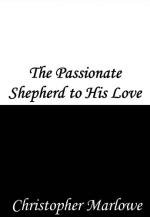|
This section contains 543 words (approx. 2 pages at 400 words per page) |

|
The Passionate Shepherd to His Love Summary & Study Guide Description
The Passionate Shepherd to His Love Summary & Study Guide includes comprehensive information and analysis to help you understand the book. This study guide contains the following sections:
This detailed literature summary also contains Bibliography on The Passionate Shepherd to His Love by Christopher Marlowe.
Christopher Marlowe's "The Passionate Shepherd to His Love" fits perfectly into the poetic genre of the period. Poets of the Elizabethan age used poetry as a way to express their wit and talent. It is likely that Marlowe's poem would have been passed around among his friends long before its publication in 1599 in England, six years after the poet's death. Few Elizabethan poets published their own work, especially one as young as Marlowe, and so it is fairly certain that the poem was well-known long before its publication. The composition date is thought to be about 1588, and probably it generated many responses well before its publication nearly a dozen years later. Among these responses was Sir Walter Raleigh's "The Nymph's Reply to the Shepherd" (date unknown, but thought to be about 1592), which provides the woman's response to Marlowe's shepherd. Marlowe's poem also inspired several other notable works that were similar in tone and content, including John Donne's "The Bait" (1633), which also relies upon wit and sexuality to entertain the reader.
"The Passionate Shepherd to His Love" is written in the pastoral tradition that originated with Theocritus in Greece during the third century b.c. The pastoral tradition is characterized by a state of contentment and of innocent and romantic love. Rural country folk are presented in an idealized natural setting, while they contemplate their perfect and peaceful world that is absent the worries and issues of crowded city life. As was common of Elizabethan poets, Marlowe plays with the traditional pastoral formula. He introduces sexuality and includes images that make the shepherd's plea seem ridiculous rather than ideal.
The speaker in "The Passionate Shepherd to His Love" is a shepherd, who pledges to do the impossible if only the female object of his desires will accept his pleas. The poem is static in time, with no history or clearly defined future. Only the present matters. There is never any suggestion that the poet is asking the woman for a long-term commitment; there is no offer of marriage nor does he offer a long-term future together. Instead, he asks her to come and live with him and seek pleasure in the moment. The use of "passionate" in the title suggests strong emotions, but may also refer to an ardent desire to possess the woman sexually, since there is never any declaration of love. The shepherd makes a number of elaborate promises that are generally improbable and occasionally impossible. The woman's response is never heard, and she is not present in any way except as the object of the shepherd's desire.
Prior to the composition of "The Passionate Shepherd to His Love," early English Renaissance poetry had been most concerned with romantic love. These poems, which included poems by Sir Thomas Wyatt and Henry Howard, were traditional love poems, characterized by the pleas of a rejected suitor who would find solace in the soothing atmosphere of country life. Marlowe tweaked the traditional, transforming it into a more dynamic piece. As a result, Marlowe's poem remains a long lasting and important example of the Elizabethan poet's talent. "The Passionate Shepherd to His Love" is included in most literature anthologies published for academic use, including the seventh edition of the Norton Anthology of English Literature.
Read more from the Study Guide
|
This section contains 543 words (approx. 2 pages at 400 words per page) |

|



